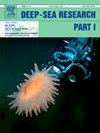热带风暴“花木兰”对南中国海北部一个反气旋涡旋的全面破坏
IF 2.3
3区 地球科学
Q2 OCEANOGRAPHY
Deep-Sea Research Part I-Oceanographic Research Papers
Pub Date : 2025-04-08
DOI:10.1016/j.dsr.2025.104500
引用次数: 0
摘要
2022年8月,热带风暴“花木兰”经过中国南海北部时,两架“海翼”水下滑翔机观测到一个反气旋涡旋(AE)的破坏。通过整合滑翔机观测和HYCOM输出,研究了声发射中三维结构的破坏和涡流动能(EKE)的耗散。花木兰引起的强扰动破坏了AE内部温暖的低盐度岩心。强烈的风应力通过加速(逆转)声发射西(东)区的气流,破坏了声发射周围的上层反气旋气流。这严重破坏了AE独特的三维结构,导致EKE和涡流势能(EPE)分别降低57%和96%。此外,EKE预算分析表明,在花木兰通过前、期间和之后,EPE到EKE的转换、风应力功和压力功散度分别是EKE的主要来源。然而,EKE的耗散主要是在其通过过程中直接受到木兰诱导的湍流混合和通过后与近惯性波相关的强垂直混合的驱动。据我们所知,这是第一次研究阐明在整个热带气旋-涡旋相互作用期间导致或消散南海剧烈EKE变化的多种动力过程。这些发现促进了我们对热带气旋-涡旋相互作用下声发射中三维结构破坏和复杂海洋能量转移机制的理解。本文章由计算机程序翻译,如有差异,请以英文原文为准。
Full destruction of an anticyclonic eddy in the Northern South China Sea by Tropical Storm Mulan
The destruction of an anticyclonic eddy (AE) as a Tropical Storm, Mulan, passed through the northern South China Sea in August 2022 was observed by two Sea Wing underwater gliders. By integrating glider observations and HYCOM outputs, this study investigated 3D structural destruction and dissipation of eddy kinetic energy (EKE) within an AE. The warm and low-salinity core inside the AE was devastated by Mulan-induced strong disturbances. Intense wind stress disrupted the upper anticyclonic flow around the AE by accelerating (reversing) the flow in the western (eastern) part of the AE. These severely destroyed the unique 3D structure of the AE and led to 57 % and 96 % reductions in EKE and eddy potential energy (EPE), respectively. Furthermore, EKE budget analyses demonstrated that the EPE to EKE conversion, wind stress work, and divergence of pressure work served as dominant sources of EKE before, during, and after Mulan's passage, respectively. However, the EKE dissipation was primarily driven by Mulan-induced turbulent mixing directly during its passage and strong vertical mixing associated with near-inertial waves after its passage. To our knowledge, this is the first study to elucidate the multiple dynamic processes contributing to or dissipating dramatic EKE changes in the South China Sea over the entire tropical cyclone-eddy interaction period. These findings advance our understanding of 3D structural destruction and complex oceanic energy transfer mechanisms within the AE under tropical cyclone-eddy interactions.
求助全文
通过发布文献求助,成功后即可免费获取论文全文。
去求助
来源期刊
CiteScore
4.60
自引率
4.20%
发文量
144
审稿时长
18.3 weeks
期刊介绍:
Deep-Sea Research Part I: Oceanographic Research Papers is devoted to the publication of the results of original scientific research, including theoretical work of evident oceanographic applicability; and the solution of instrumental or methodological problems with evidence of successful use. The journal is distinguished by its interdisciplinary nature and its breadth, covering the geological, physical, chemical and biological aspects of the ocean and its boundaries with the sea floor and the atmosphere. In addition to regular "Research Papers" and "Instruments and Methods" papers, briefer communications may be published as "Notes". Supplemental matter, such as extensive data tables or graphs and multimedia content, may be published as electronic appendices.

 求助内容:
求助内容: 应助结果提醒方式:
应助结果提醒方式:


